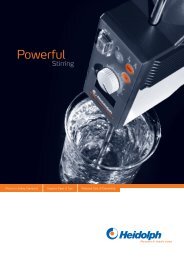download - Gaia Science
download - Gaia Science
download - Gaia Science
Create successful ePaper yourself
Turn your PDF publications into a flip-book with our unique Google optimized e-Paper software.
attolight<br />
Attolight AG<br />
EPFL Innovation Square<br />
PSE D<br />
1015<br />
TRCL is<br />
Lausanne<br />
a High-Resolution Technique<br />
Switzerland<br />
t<br />
Given<br />
+41 21<br />
the<br />
626<br />
context<br />
0100<br />
of developing nanosciences,<br />
there is currently a growing interest in obtaining<br />
local information about light-emitting<br />
www.attolight.com<br />
phenomena in condensed matter. In particular,<br />
dynamical information such as the luminescence<br />
decay time is of major importance to<br />
analyse the competition between radiative and<br />
nonradiative processes in materials and nanostructures<br />
designed to serve in optoelectronic<br />
devices.<br />
However, while it is easy to measure the photoluminescence<br />
decay dynamics with a spatial<br />
resolution of a few hundreds of squared micrometers,<br />
achieving such measurements at<br />
the scale of a few tens of nanometers is still<br />
challenging.<br />
Therefore, in most instances, TR-PL experiments<br />
only provide information that is integrated<br />
over a number of light-emitting nanoobjects<br />
and over a number of competitive<br />
processes: radiative processes themselves, carrier<br />
transfer among different radiative or nonradiative<br />
centers, nonradiative carrier recombination…<br />
In the case of individual nano-objects or of<br />
materials comprising a variety of light-emitting<br />
sub-structures, such integrated information is<br />
not detailed enough and leads to conjectural<br />
analyses of the recorded data.<br />
On the other hand, thanks to a strongly localized<br />
excitation, TRCL permits to isolate (spatially<br />
and spectrally) the different light sources<br />
and to analyse their dynamical characteristics<br />
separately.<br />
Interest of Temperature-dependent TRCL<br />
Like for other spectroscopic techniques the<br />
possibility to use cryogenic temperatures has<br />
several beneficial effects.<br />
First of all, by hindering thermally-enhanced<br />
nonradiative recombinations, low temperatures<br />
increase drastically the signal-to-noise ratio.<br />
For the same reason, the CL decay dynamics<br />
measured at low-temperatures are closer (if<br />
TECHNICAL NOTE<br />
not exactly identical) to the purely radiative<br />
dynamics.<br />
Indeed, the effective decay time, τCL, is related<br />
to the radiative (τR) and nonradiative (τNR)<br />
lifetimes by: τCL =(τR-1 + τNR-1)-1. In other<br />
words, when the sample is placed at low temperatures,<br />
the nonradiative lifetime becomes<br />
so long that the effective lifetime is close to the<br />
radiative lifetime. The latter is a precious piece<br />
of information, especially in the study of lowdimensional<br />
semiconductor systems such as<br />
quantum wells or quantum dots.<br />
The second favourable effect of low temperatures<br />
is the reduction of emission linewidths.<br />
Whenever several optical transitions, corresponding<br />
to various recombination mechanisms,<br />
are close in energy, this linewidth reduction<br />
permits to separate these mechanisms.<br />
In CL, this point is quite often very profitable<br />
because the different mechanisms can correspond<br />
to different localizations in space. In<br />
TRCL, the temporal behaviours pertaining to<br />
these different mechanisms can be studied<br />
separately.<br />
The third advantage of low temperatures is<br />
that it reduces the diffusion of carriers across<br />
the sample and generally favours optical recombination<br />
of localised excitons. Consequently,<br />
the CL images obtained are sharper:<br />
the resolution, specially in monochromatic detection<br />
mode, is enhanced.<br />
There is also clearly an interest for experiments<br />
conducted under variable temperature conditions.<br />
This is particularly true when dealing<br />
with carrier diffusion/capture processes that<br />
can be studied by analysing the CL rise-times.<br />
Their behaviour when T is changed, along with<br />
the appropriate modelling, provides crucial<br />
information on diffusion coefficients, energy<br />
transfer mechanisms, activation energies…<br />
TRCL is an Excitation Spectroscopy Technique<br />
Contrary to the intuitive approach, cathodoluminescence,<br />
when seen as a mapping method,<br />
does not show, strictly speaking, where the<br />
emitted light comes from. In fact, it rather correlates,<br />
with very high resolution, the 2D coor-<br />
© 2011 Attolight AG - All rights reserved.




